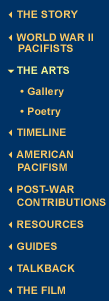|
The legacy of conscientious objection is not limited to political action and social reform. WWII COs made a significant contribution to the arts during the war years as well. Of the 45,000 Americans who declared themselves conscientious objectors during World War II, a number went on to become important figures in the cultural life of the United States. William Everson (later known as Brother Antonius, the Beat Friar), William Stafford (beloved teacher and poet laureate of Oregon) and Robert Lowell (who later was appointed poet laureate of the U.S.) were among the poets who refused to fight in the Second World War. (Read poems by William Everson and William Stafford.)
Located in a Church of the Brethren camp on the rugged Oregon coast, The Fine Arts Camp at Waldport, founded by poet William Everson, brought together talented individuals from many disciplines. Poets, writers, theater workers, painters, woodworkers, ceramic and silk screen artists, photographers, fine art printers and an architect were among those allowed to transfer to the camp. There they developed a dynamic program in the arts in their free time - after a 60-hour week of hard labor reforesting a devastated area on the coast.
These interned draftees planted a million and a half trees, and five men lost their lives. After hours, they performed plays by Chekhov, read the works of Edna St. Vincent Millay, and put on a witty version of popular operetta The Mikado. They bought an old printing press, and CO Adrian Wilson learned the craft of letter set printing and typography from William Everson, the son of a printer. (Wilson later became one of the pre-eminent book designers of the 20th century, winning the MacArthur Genius Award for his work.) At Waldport, they produced two magazines, The Illiterati and The Compass, in addition to programs for the plays and elegant books of poetry.
"Our early books were dazzling, and in the reviews in the East, they were as praised for their typography and layout, presswork and design as they were for their contents. In fact, many times more."
- William Everson
In camp they held concerts with a quartet including Brodus Earle, who later became the concertmaster of the Tokyo Symphony. They held regular poetry readings, a practice that had been limited to the New York City's 92nd Street YMCA up to that point.
At Waldport, wives and women friends rented tourist cabins at the beach and performed in the theater productions at the camp. Together in post-war San Francisco they founded the Interplayers Theater.
Poets Kenneth Patchen, Kenneth Rexroth, and writer Henry Miller were pacifists who joined the new arrivals from Waldport, and birthed the "San Francisco Renaissance" in the arts which evolved into the "Beat Movement" of the 1950s.
The legacy of conscientious objection in the arts was not limited to Waldport. Lewis Hill had been in a CPS camp in Coleville, California. After the war he and several other COs founded the Pacifica Network and KPFA Radio in Berkeley, the world's first listener-sponsored radio station. KPFA was home to wide-ranging debates stretching the Cold War limits of free speech, weekly film reviews by Pauline Kael, lectures on Zen Buddhism by Alan Watts and poetry readings by Brother Antoninus, Lawrence Ferlinghetti and Alan Ginsberg. The pioneering network brought the world of art and politics to the airwaves as never before. Ever immersed in controversy and threatened with calamity, the station CO Lew Hill envisioned remains the flagship of free speech listener-sponsored, non-commercial radio in the U.S. today.
Asa Watkins was among the first COs to work as an attendant in a mental hospital in Virginia. His work with the mental patients had a profound influence on his artwork. View some of his works in the gallery.
|
